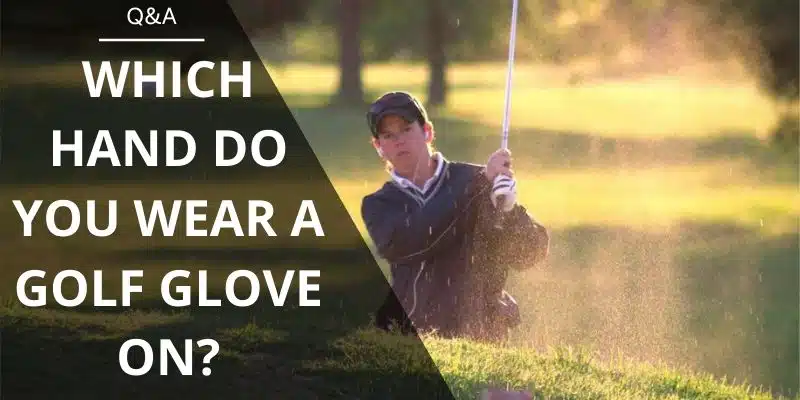Given the high prices we usually pay for them, and the fact that they are made of metal, we would be right to assume that golf clubs should not break very easily.
But sadly, we are sometimes proven wrong. Strong and durable as they may be, golf clubs can indeed break, and it can happen for a number of reasons.
So why do golf clubs break? Sometimes, there is a fault in the club that is out of the player’s control. Other times, it’s the player who is to blame. In this article, we’ll explore the most common reasons for golf club breakage, and we’ll provide tips on how you can prevent it from happening.
8 Reasons Why Golf Clubs Break
1. Rust
Where there’s metal, there’s also rust. Especially wet metal.
A rusted shaft is one of the most common causes of golf club breakage. If water manages to find its way to the inside of your club, then you’re probably in for some trouble. It will slowly rot your club from the inside – which you won’t be able to see – and before you know it, your shaft has split apart.
Of course, rust can also occur on the outside of your club. And once it starts, it’s hard to get rid of it – your club will slowly suffer, and eventually break entirely.
Solution:
Use a golf towel to dry off your clubs after a rainy round. Always store your clubs in a dry location inside, or at least under shelter.
When cleaning your clubs, try to avoid submerging your clubs in water. Use a damp cloth to wipe them, and then immediately dry them off with a towel.
2. Age
Even the most exquisitely engineered golf clubs are not necessarily designed to live forever. Over time, components inevitably start to break down, eventually deteriorating to the point where they are no longer functional.
You shouldn’t really have to worry about this if you are using a club that is less than 10 years old. Once it starts pushing towards 20 years of age and beyond, however, then you might see some cracks begin to show.
Whether it’s the grooves on the clubface fading, the grip falling apart, the glues drying out, or the metal weakening, time will eventually have its way with your club, one way or another. It might be a slow process, or it might just suddenly break one day.
Solution:
If you have a sentimental attachment to an old golf club, you might be reluctant to replace it. If that’s the case, you could consider replacing the individual parts. For instance, it shouldn’t be too difficult to have the grip replaced if your current grip is wearing and tearing.
However, your club might have deteriorated beyond the point of repair, in which case it’s time to bite the bullet and acquire a new club. This could be a blessing in disguise: club technology has upgraded so much in recent years, that purchasing a more modern club could completely transform your game.
3. Player Abusing the Club
Let’s be honest… golf can be infuriating at times. One minute you’re flying high stringing pars and birdies, the next minute your whacking weeds and missing two-foot putts.
Everyone feels anger at some point when playing golf, and some players decide to take this anger out on their clubs. They might slam it on the ground, snap it over their leg, or launch it at a nearby tree. It might be amusing for an observer, but for the club itself, this kind of behavior is almost always fatal.
Steel or not, a golf club can only withstand so much abuse. Most of the time they will bend out of shape, but sometimes they will snap clean in two. Either way, it will probably be broken beyond repair.
Solution:
Anger is anger; sometimes it’s impossible to avoid. But I’ve found that taking a few deep breaths is an effective way to cool myself down after some bad play.
Also, as hard as it seems sometimes, I try not to dwell on what has just happened and instead focus on the next hole. If you can manage this, your golf clubs will lead a longer and happier life!
4. A Dodgy Swing
Everyone, including the pros, is guilty of playing the odd mishit here and there. Most of the time, this will simply result in a bad shot. But every once in a while, a dodgy swing can result in a broken club.
This is more likely to occur if you are playing from a tricky location – for instance, next to a tree or a stone path. If your club comes into contact with something solid (that isn’t a golf ball) during your swing, it is very likely to suffer substantial damage.
But of course, this could even happen on the tee or the fairway. If you make too much contact with the ground, otherwise known as a fat shot, a number of problems can arise, including a broken clubhead and/or a bent or broken shaft.
Solution:
If you find yourself hitting from a challenging location close to some unfriendly obstacles, remember that you always have the option to take a drop. Although it will cost you a penalty shot, it could potentially save you a lot of money as you won’t have to replace a broken club.
If you find that you are hitting regular fat shots, then there’s likely to be something wrong with your swing. Consider taking some lessons, or at least spend some time on the range to sort it out.
5. Keeping Clubs In the Car
It can be tempting to permanently store your clubs in the trunk of your car. It means that they don’t take up space in your house or garage, and it is slightly less hassle for you to get out and play.
But this is a big mistake and one that is the downfall of many a golf club.
The problem is the temperature. Cars get super hot, especially in the summer. Over time, heat will deteriorate the epoxy – the glue that holds the shaft and the head together – causing clubheads to eventually come loose.
This doesn’t happen overnight, so don’t panic if you left them there for a short while. But making a regular habit of leaving your clubs in the car is ill-advised.
Solution:
Find a cool place to store your clubs. A garage is usually the best bet. As well as more agreeable temperatures, they also offer increased security.
6. Clubs Rattling Against Each Other In the Bag
When your clubs are all bundled together in your bag, they are naturally going to rattle against each other as you carry them around.
While club manufacturers have, to some extent, accounted for this in their designs, it’s possible that your clubs can succumb to scratches and dents. Over time, this can result in irreparable damage to the metal.
This happens far more often to players who have a tendency to drop their bags in a carefree manner. We all hear that horrible sound of metal crashing together, but we might not immediately see the damage this does to the clubs.
Similarly, if clubs are not properly secured when using a golf cart, they will rattle about relentlessly, taking increasing amounts of damage over time. Worse yet, a bag that is not properly strapped in could fall from the back, which can easily cause some serious damage to your clubs.
Solution:
It’s worth considering purchasing a bag with a 14-way divider. These bags give each of your golf clubs its own sleeve, meaning they won’t be touching and rattling against others. Dividers also make it a lot easier to keep your bag organized.
Headcovers are an essential piece of kit for keeping your clubs intact – especially your woods. Irons are more robust, and generally don’t warrant the use of headcovers. But your drivers, 3 woods, and hybrids won’t stand up well to club rattling, so they should always be protected. Many players also use a headcover for their putter.
When using a golf cart, make sure your bag is strapped in and fastened tightly, such that it won’t move about as you round corners and go up and down hills.
7. Badly Made Golf Clubs
Not all golf clubs are created equally. Some clubs are so poorly made that they’ll likely come apart at the first sign of trouble.
There are a number of knock-off brands or extremely budgeted options out there. Though purchasing from such companies may save you money to start with, the clubs themselves probably won’t last half as long as they should, meaning you will end up spending more money to replace them.
If you stick to the likes of Titleist, Callaway, and PING, then you can rest assured you’re working with some quality clubs. These big companies employ rigorous quality control measures. They use the most robust materials and assemble them with care.
Solution:
Stick to reputable brands. Even if it means spending a bit more money, the extra assurance of quality and durability is almost always worth it.
8. Manufacturing Defects
Despite having comprehensive quality control measures, even the most reputable manufacturers sometimes allow club defects to slip through the net.
Just one tiny, incorrect detail could completely compromise the durability of a club. In extreme cases, you might find that the head of your brand new, $500 driver comes flying off after the second or third hit.
If something like this happens, the likelihood is that there’s a manufacturing defect. It’s frustrating, certainly, but the good news is that it shouldn’t cost you any more money to replace.
Solution:
Contact the manufacturer and explain what happened. Most breaks of this nature are covered under a warranty. You’ll then be asked to send the club back to the manufacturer using a prepaid shipping label. After determining what the defect is, they’ll either fix the club and send it back to you, or send you a new replacement. Both will be free of charge.
Final Thoughts
Golf club breakages can occur for a number of reasons, but there are steps that you as a player can take to prevent it from happening.
Keep them dry, and store them in a cool and secure location. Watch where you’re swinging; be careful of trees, rocks, and other obstacles, and try to avoid those fat shots. Consider purchasing a bag with a 14-way divider, and make sure you’ve got headcovers on your woods. Treat them with care, and of course… control the anger!
And if they break as a result of it being badly made or having a defect, establish your consumer rights and have them replaced. You’ll be back swinging in no time!
Related Articles
- Why are golf clubs so expensive?
- Best Boxes To Ship Golf Clubs
- The Best Golf Club Covers
- The Best Golf Cart Bags
Nick is the founder of GolfSpan and an avid golfer. He's not quite a pro but has over 15 years of experience playing and coaching golfers worldwide. His mission is to bring the golfing community a better experience when it comes to choosing the right golf gear and finding the right setup for your game.






